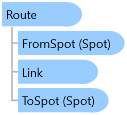
A
Route is an object associated with a Link that computes and remembers the set of points that the link should follow to connect two nodes.Object Model

Syntax
[DesignTimeVisible(false)] [StyleTypedProperty(Property="FocusVisualStyle", StyleTargetType=System.Windows.Controls.Control)] [XmlLangProperty("Language")] [UsableDuringInitialization(true)] [RuntimeNameProperty("Name")] [UidProperty("Uid")] [TypeDescriptionProvider(MS.Internal.ComponentModel.DependencyObjectProvider)] [NameScopeProperty("NameScope", System.Windows.NameScope)] public class Route : System.Windows.FrameworkElement
Remarks
The only use of a Route in XAML is as the value of the Route attached property: <DataTemplate x:Key="MyLinkTemplate"> <go:LinkPanel go:Link.SelectionElementName="Path" go:Part.SelectionAdorned="True"> <go:Link.Route> <go:Route Routing="Orthogonal" Corner="10" RelinkableFrom="True" RelinkableTo="True" /> </go:Link.Route> <go:LinkShape x:Name="Path" Stroke="Black" StrokeThickness="1" /> <Path Fill="Black" go:LinkPanel.ToArrow="Standard" /> </go:LinkPanel> </DataTemplate>
Although this class inherits from FrameworkElement in order to support data binding, it is not really a FrameworkElement or UIElement! Please ignore all of the properties, methods, and events defined by FrameworkElement and UIElement.
Inheritance Hierarchy
System.Object
System.Windows.Threading.DispatcherObject
System.Windows.DependencyObject
System.Windows.Media.Visual
System.Windows.UIElement
System.Windows.FrameworkElement
Northwoods.GoXam.Route
See Also